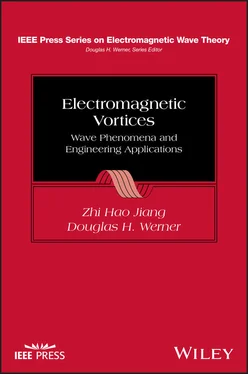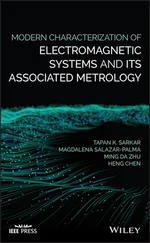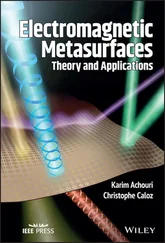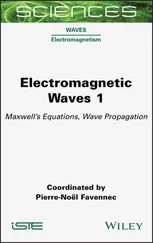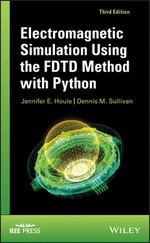Menglin L. N. Chen
Department of Electrical and Electronic Engineering
The University of Hong Kong
Hong Kong, P.R. China
Yuqi Chen
College of Information Science and Electronic Engineering
Zhejiang University
Hangzhou, P.R. China
Xiaoming Chen
School of Electronic and Information Engineering, Xi'an Jiaotong
University, Xi’an, P.R. China
Tie Jun Cui
State Key Laboratory of Millimeter‐Waves, School of Information Science and Engineering, Southeast University
Nanjing, P.R. China
Alessio D’Errico
Department of Physics
University of Ottawa
Ottawa, ON, Canada
Mina Hanifeh
Department of Electrical Engineering and Computer Science
University of California
Irvine, CA, USA
Wei Hong
State Key Laboratory of Millimeter‐Waves
School of Information Science and Engineering
Southeast University
Nanjing, P.R. China
Naoki Honma
Faculty of Science and Engineering
Iwate University
Morioka, Iwate, Japan
Nanzhe Hu
Department of Electrical and Computer Engineering, University of Southern California
Los Angeles, CA, USA
Hao Huang
Department of Electrical and Computer Engineering, University of Southern California
Los Angeles, CA, USA
Zhi Hao Jiang
State Key Laboratory of Millimeter‐Waves, School of Information Science and Engineering, Southeast University
Nanjing, P.R. China
Li Jun Jiang
Department of Electrical and Electronic Engineering, The University of Hong Kong
Hong Kong, P.R. China
Lei Kang
Department of Electrical Engineering
The Pennsylvania State University
University Park, PA, USA
Ebrahim Karimi
Department of Physics
University of Ottawa
Ottawa, ON, Canada
Natalia M. Litchinitser
Department of Electrical and Computer Engineering, Duke University
Durham NC, USA
Cong Liu
Department of Electrical and Computer Engineering, University of Southern California
Los Angeles, CA, USA
Kentaro Murata
Faculty of Science and Engineering
Iwate University
Morioka, Iwate, Japan
Kai Pang
Department of Electrical and Computer Engineering, University of Southern California
Los Angeles, CA, USA
Anastasios Papathanasopoulos
Department of Electrical and Computer Engineering, University of California
Los Angeles, CA, USA
Cheng‐Wei Qiu
Department of Electrical and Computer Engineering, National University of Singapore
Singapore
Yahya Rahmat‐Samii
Department of Electrical and Computer Engineering, University of California
Los Angeles, CA, USA
Yongxiong Ren
Department of Electrical and Computer Engineering, University of Southern California
Los Angeles, CA, USA
Wei E. I. Sha
Key Laboratory of Micro‐nano Electronic Devices and Smart Systems of Zhejiang Province, College of Information Science and Electronic Engineering, Zhejiang University
Hangzhou, P.R. China
Haoqian Song
Department of Electrical and Computer Engineering, University of Southern California
Los Angeles, CA, USA
Hao Song
Department of Electrical and Computer Engineering, University of Southern California
Los Angeles, CA, USA
Xinzhou Su
Department of Electrical and Computer Engineering, University of Southern California
Los Angeles, CA, USA
Fabrizio Tamburini
ZKM Karlsruhe, Lorenzstraße, Berlin, Germany
Bo Thidé
Swedish Institute of Space PhysicsÅngström Laboratory, Uppsala, Sweden
Moshe Tur
School of Electrical Engineering
Tel Aviv University
Ramat Aviv, Israel
Zhixia Wang
College of Information Science and Electronic Engineering
Zhejiang University, Hangzhou
P.R. China
Xinyue Wang
College of Information Science and Electronic Engineering, Zhejiang University
Hangzhou, P.R. China
Douglas H. Werner
Department of Electrical Engineering
The Pennsylvania State University
University Park, PA, USA
Alan E. Willner
Department of Electrical and Computer Engineering, University of Southern California
Los Angeles, CA, USA
Guodong Xie
Department of Electrical and Computer Engineering, University of Southern California
Los Angeles, CA, USA
Xiaoyan Y. Z. Xiong
Department of Electrical and Electronic Engineering, The University of Hong Kong
Hong Kong, P.R. China
Xiaowen Xiong
College of Information Science and Electronic Engineering, Zhejiang University
Hangzhou, P.R. China
Wei Xue
School of Electronic and Information Engineering, Xi'an Jiaotong University
Xi’an, P.R. China
Yuanjie Yang
School of Physics, University of Electronic Science and Technology of China
Chengdu, P.R. China
Jianjia Yi
School of Information and Communications Engineering, Xi’an Jiaotong University
Xi’an, P.R. China
Jia Yuan Yin
School of Physics and Optoelectronic Engineering, Xidian University
Xi’an, P.R. China
Runzhou Zhang
Department of Electrical and Computer Engineering, University of Southern California
Los Angeles, CA, USA
Xianmin Zhang
College of Information Science and Electronic Engineering, Zhejiang University
Hangzhou, P.R. China
Ningbo Research Institute, Zhejiang University
Ningbo, P.R. China
Zhe Zhao
Department of Electrical and Computer Engineering, University of Southern California
Los Angeles, CA, USA
Jiayu Zheng
College of Information Science and Electronic Engineering
Zhejiang University
Hangzhou, P.R. China
Shilie Zheng
College of Information Science and Electronic Engineering, Zhejiang University
Hangzhou, P.R. China
Ningbo Research Institute
Zhejiang University, Ningbo, P.R. China
Huibin Zhou
Department of Electrical and Computer Engineering, University of Southern California
Los Angeles, CA, USA
Zelin Zhu
College of Information Science and Electronic Engineering, Zhejiang University, Hangzhou, P.R. China
The content of this book is focused on the cutting‐edge research area of electromagnetic vortices including fundamental theory, wave phenomena, and also the applications of vortex waves in a variety of disciplines. Akin to vortices that exist widely throughout nature, ranging from a fluid vortex with a central flow singularity to the countless spiral galaxies in the universe, vortices also exist in electromagnetic and optical fields which are manifested in what are called vortex waves. Such vortex waves refer to a class of electromagnetic waves carrying nonvanishing orbital angular momentum (OAM), which are characterized by their helical phase‐front and annular‐shaped intensity distribution, indicating a singularity at the beam center. This family of waves encompasses unconventional waveforms with complex structures such as vector vortex beams, higher‐order Bessel beams, etc. Their structured wavefronts endow them with unprecedented wave behavior that breaks conventional bounds enabling new physical properties, revealing a subtle connection between macroscopic physical optics and microscopic quantum optics. These unique properties have further led to the creation of revolutionary new ways of exploiting wave‐matter interactions, especially when coupled with interdisciplinary research areas such as nanophotonics, metamaterials, communications, nonlinear optics, quantum information, etc. Ever since the introduction of the concept of electromagnetic vortices in 1989 by Coullet et al. and the first demonstration of OAM in paraxially propagating vortex beams by Allen et al., there has been a dramatically increasing number of scientists and engineers enthusiastically devoting their efforts to this field of exploration. In particular, over the past few years, the field of electromagnetic vortices has witnessed tremendous advancements in many of its associated subareas, which have jointly enabled devices and even systems for a wide variety of applications including astrophysical observation, particle manipulation, nonlinear optics, microlasers, fiber optics, wireless communications, and even quantum cryptography, just to name a few. As such, electromagnetic vortices hold great promise for revolutionizing developments in many research areas and triggering key disruptive technologies that have the potential to change the daily lives of human beings.
Читать дальше
